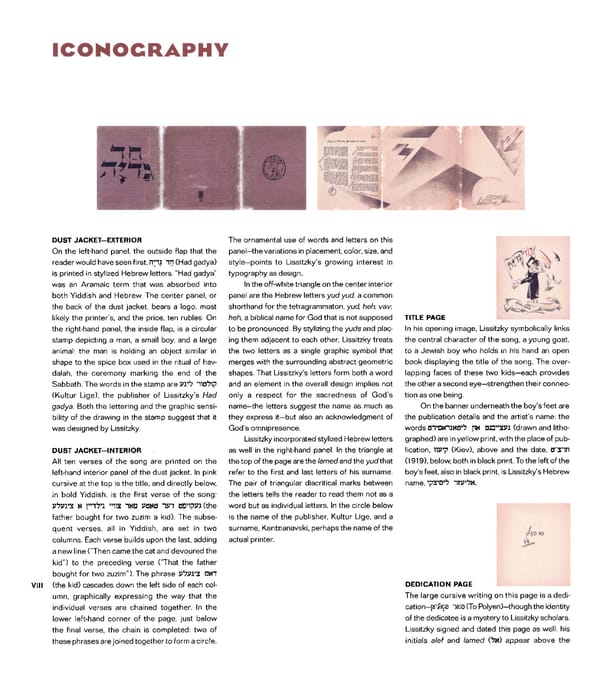ICONOGRAPHY DUST JACKETEXTERIOR The ornamental use of words and letters on this On the lefthand panel, the outside flap that the panel—the variations in placement, color, size, and reader would have seen first, HH1 IV} (Had gadya) style—points to Lissitzky's growing interest in is printed in stylized Hebrew letters. "Had gadya" typography as design. was an Aramaic term that was absorbed into In the offwhite triangle on the center interior both Yiddish and Hebrew. The center panel, or panel are the Hebrew letters yud yud, a common the back of the dust jacket, bears a logo, most shorthand for the tetragrammaton, yud, heh, vav, likely the printer's, and the price, ten rubles. On heh, a biblical name for God that is not supposed TITLE PAGE the righthand panel, the inside flap, is a circular to be pronounced. By stylizing the yuds and plac In his opening image, Lissitzky symbolically links stamp depicting a man, a small boy, and a large ing them adjacent to each other, Lissitzky treats the central character of the song, a young goat, animal: the man is holding an object similar in the two letters as a single graphic symbol that to a Jewish boy who holds in his hand an open shape to the spice box used in the ritual of hav merges with the surrounding abstract geometric book displaying the title of the song. The over dalah, the ceremony marking the end of the shapes. That Lissitzky's letters form both a word lapping faces of these two kids—each provides 1 the other a second eye—strengthen their connec Sabbath. The words in the stamp are PI'? mC3*?1p and an element in the overall design implies not (Kultur Lige), the publisher of Lissitzky's Had only a respect for the sacredness of God's tion as one being. gadya. Both the lettering and the graphic sensi name—the letters suggest the name as much as On the banner underneath the boy's feet are bility of the drawing in the stamp suggest that it they express it—but also an acknowledgment of the publication details and the artist's name: the , was designed by Lissitzky. God's omnipresence. words aTa*rUNB'7 J1K flJrrXPI (drawn and litho Lissitzky incorporated stylized Hebrew letters graphed) are in yellow print, with the place of pub DUST JACKETINTERIOR as well in the righthand panel. In the triangle at lication, llP'p (Kiev), above and the date, arm All ten verses of the song are printed on the the top of the page are the lamed and the yud that (1919), below, both in black print. To the left of the lefthand interior panel of the dust jacket. In pink refer to the first and last letters of his surname. boy's feet, also in black print, is Lissitzky's Hebrew cursive at the top is the title, and directly below, The pair of triangular diacritical marks between name, rpro*? TTP^K. in bold Yiddish, is the first verse of the song: the letters tells the reader to read them not as a p^pa^t « "iK3 POKO TPI aanppKthe word but as individual letters. In the circle below father bought for two zuzim a kid). The subse is the name of the publisher, Kultur Lige, and a quent verses, all in Yiddish, are set in two surname, Kentzianavski, perhaps the name of the columns. Each verse builds upon the last, adding actual printer. a new line ("Then came the cat and devoured the kid") to the preceding verse ("That the father bought for two zuzim"). The phrase P'PPRX VIII (the kid) cascades down the left side of each col DEDICATION PAGE umn, graphically expressing the way that the The large cursive writing on this page is a dedi individual verses are chained together. In the cation— pr/ica Ilea (To Polyen)—though the identity lower lefthand corner of the page, just below of the dedicatee is a mystery to Lissitzky scholars. the final verse, the chain is completed: two of Lissitzky signed and dated this page as well: his these phrases are joined together to form a circle. initials alef and lamed (*?K) appear above the
 Had Gadya The Only Kid: Lissitzky 1919 Page 9 Page 11
Had Gadya The Only Kid: Lissitzky 1919 Page 9 Page 11